by W.F. Andelt, S. Ahmed and K. Jones* (11/15)
Quick Facts…
- Eight species of voles are found in Colorado. They often are called meadow, field or pine mice.
- Voles are small mammals that cause damage by girdling seedling and mature trees in orchards, shelterbelts and forests. They also damage field crops and frequently construct runways in lawns.
- Damage by voles can be reduced by habitat modification, exclusion, repellents, trapping, and poison grain baits.
Introduction
Voles are small rodents that measure 4 to 8.5 inches long and weigh 0.8 to 3 ounces and vary in color from brown to gray. They are pudgy, with blunt faces and small eyes, small and sometimes inconspicuous ears, short legs, and a short (the long-tailed vole is an exception) and scantily haired tail.
Eight species of voles are found widely throughout various ecosystems of Colorado, in heavy ground cover of grasses, grass-like plants, and litter.
Southern red-backed voles (Myodes gapperi) are found in moist and well-developed coniferous forests. They are most abundant in lodgepole pine (Pinus contorta) stands, usually between 8,000 and 11,000 feet.
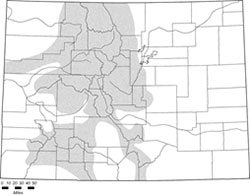 Figure 1: Southern red-backed vole distribution.3 |
Meadow voles (Microtus pennsylvanicus) primarily occur from north to south central Colorado and along the South Platte River. They tend to live in or near damp marshy areas or wet meadows and riparian corridors.
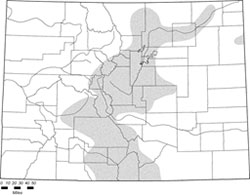 Figure 2: Meadow vole distribution.3 |
Montane voles (Microtus montanus) primarily are found in the western half of Colorado in moist meadows and valleys with thick grass or forb cover from 6,000 feet to above timberline.
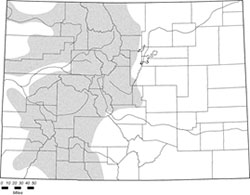 Figure 3: Montane vole distribution.3 |
Long-tailed voles (Microtus longicaudus) are common over the mountains and high plateaus of the western half of Colorado. They are most abundant in streamside meadows in marshy to dry grassy areas.
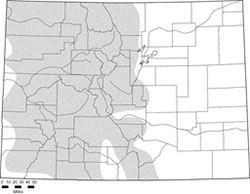 Figure 4: Long-tailed vole distribution.3 |
Mogollon voles (Microtus mogollonensis)are found in the very southern part of Colorado, in Las Animas and Montezuma Counties. They occur in ponderosa pine (Pinus ponderosa) woodland or savannah, pinon (Pinus edulis Engelm)–juniper (Juniperus monosperma and Juniperus scopulorum) woodlands or montane shrublands.
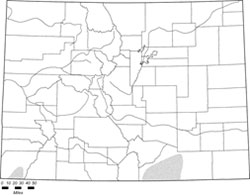 Figure 5: Mogollon vole distribution.3 |
Prairie voles (Microtus ochrogaster) are found in grasslands and along streams and irrigated lands in eastern Colorado.
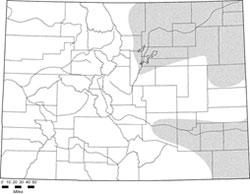 Figure 6: Prairie vole distribution.3 |
Sagebrush voles (Lemmiscus curtatus) occupy the driest of all vole habitats in Colorado. Often found in sagebrush habitat, they occur between 5,000 and 9,000 feet in western and north central Colorado.
 Figure 7: Sagebrush vole distribution.3 |
Western heather voles (Phenacomys intermedius) are found from 7,000 to above treeline of central Colorado. They occupy a variety of habitats but are most abundant along streams.
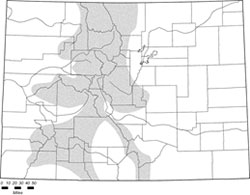 Figure 8: Western heather vole distribution.3 |
Voles eat a variety of grasses, forbs and agricultural and garden crops. They also eat bark on trees and shrubs, especially during fall and winter. While they prefer young, succulent trees and plants, they can change their diet to meet their nutritional needs.
Biology, Reproduction and Behavior
Voles are active day and night throughout the year and do not hibernate. They usually live between two and six months. Their home ranges usually are less than one-fourth acre and vary with season, food supply and population density. Voles construct many surface runways and underground tunnels with numerous burrow entrances. A single burrow may contain several adults and young.
Population densities of voles vary from species to species. Large population fluctuations that range from 14 to 500 voles per acre are common. Their numbers generally peak every three to five years. Population is influenced by dispersal, food quality, climate, predation, physiological stress, and genetics.
Voles have three to six young per litter and three to 12 litters per year. Their gestation period ranges from 20 to 23 days and they breed almost year around, although most reproduction occurs in spring, summer and fall. Females may become pregnant at three weeks of age.
Ecological Value
Voles, like many small rodents, are an important food source for many predators. A variety of predators feed on voles including coyotes, foxes, bobcats, weasels, snakes and several species of owls and hawks. Caution must be taken when using rodenticides. Zinc phosphide, a restricted use pesticide, is one control method for voles, however, it is extremely toxic and care must be taken to avoid risks to children, pets, and non-target wildlife species. Carefully read and follow the label for any rodenticide.
Damage and Control
Voles can cause extensive damage to forests, orchards and ornamental plants by girdling trees and shrubs. They prefer the bark of young trees but will attack any tree, regardless of age, when food is scarce. Monitor orchards frequently so control measures can be implemented before appreciable damage occurs. Most damage occurs in the winter when voles move through their grass runways under the protection of snow. The greatest damage seems to coincide with years of heavy snowfall.
Damage to crops, such as alfalfa, pasture grasses, clover, potatoes, carrots, beets and turnips is common and most evident when voles are at high population levels. Runways and tunnel systems constructed in agricultural fields can divert irrigation water. Voles often damage lawns and golf courses by constructing runways and burrow systems.
Vole damage to trees and shrubs is characterized by girdling and patches of irregular patterns of gnaw marks about 1/16 to 1/8-inch wide. Gnawed stems may have a pointed tip. Do not confuse vole damage with damage by rabbits, which includes stems clipped at a smooth 45-degree angle and wider gnaw marks. Stems browsed by deer usually have a rough jagged edge. Voles also girdle the roots of trees and shrubs.
Other signs of damage by voles include 1) 1 to 2 inch-wide runways through matted grass and burrows; 2) visual sightings; 3) hawks circling overhead and diving into fields; and 4) spongy soil from burrowing activity. Trees that appear to suffer from disease or insect infestation may be suffering from unseen vole damage.
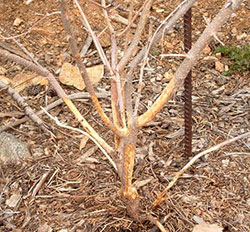 Figure 9: Vole damage on lilac. Notice small, irregular tooth marks, all under what was the snow line. 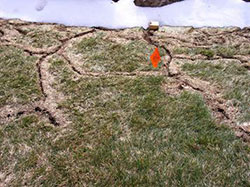 Figure 10: Vole runways in lawn after snow melted in spring. 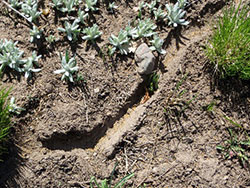 Figure 11: Vole hole and runway in clay soil. 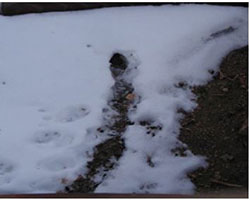 Figure 12: Vole hole and runway in snow. Note the oval-shaped OPEN hole. 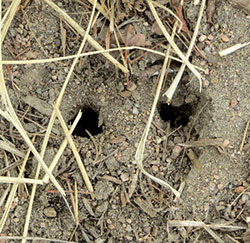 Figure 13: Examples of vole holes. They will often burrow near a rock, but not always. 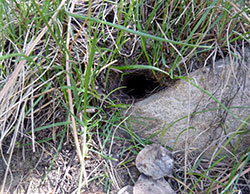 Figure 14: Examples of vole holes. They will often burrow near a rock, but not always. |
Methods to prevent and control damage are: habitat modification, exclusion, repellents, trapping, and poison grain baits. Voles are classified as non-game wildlife in Colorado and may be captured or killed when they create a nuisance or cause property damage.
Habitat Modification
High vole populations cannot become established without food and lack of predation by predators. Elimination of weed ground cover and tall grasses by frequent and close mowing, tilling, or herbicide application is the most successful and longest lasting method to reduce vole damage to orchards. This will diminish the amount of available habitat and reduce their numbers. Prunings left in orchards prevent proper mowing and provide a temporary food source, which may lead to damage by voles. Planting short grasses that do not mat or lodge, such as buffalo grass, blue grama, or dwarf fescues, will provide little protective cover and may reduce vole numbers.
Meadow voles are active during the day within their runways under thick grass and vegetation. Summer removal of vegetation (2 feet radius around fruit tree trunks) provides some protection because voles avoid exposed areas.
Damage to lawns can be reduced by close mowing in the fall before snow arrives and by mowing and removing tall grassy cover near lawns. To repair damage to lawns from runway construction, rake, fertilize and water the affected area. Close mowing and weed management in grassy borders adjacent to agricultural crops will reduce the habitat for voles and should reduce damage. If suitable, plant crown vetch (a legume unpalatable to voles) in orchard and field boundaries to reduce vole populations.
Exclusion
To protect against vole damage, encircle young trees and shrubs with 1/4-inch mesh hardware cloth or 3-inch diameter Vexar™ plastic-mesh cylinders. This barrier should project 18 inches above the ground and 3 to 6 inches below the surface. Vegetable and flower beds may also be protected in this manner.
Repellents
Only a few repellents (including Thiram™ and Hot Sauce or capsaicin) are manufactured to protect trees, shrubs and vegetable crops from voles. Little data are available on the effectiveness of repellents to deter vole damage. However, in one study, Thiram™ was reported to reduce damage to apple stems by 78 percent. A 20 percent solution of chicken eggs in water has been effective in reducing deer and elk browsing and may reduce damage by voles.
Thiram™ is manufactured by various companies and sold under various trade names. Thiram™ products are labeled for protecting most of the following from voles: tree seedlings, shrubs, ornamental plantings, nursery stock, and fruit trees. Most labels limit the use of Thiram™ on fruit trees to the dormant season.
Capsaicin (the “heat” in spicy peppers) is labeled for use on ornamental trees and shrubs, fruit and nut trees, fruit bushes and vines, and nursery stock to protect them from vole damage. Limit application to fruit-bearing plants before fruit sets or after the fruit is harvested. Hot sauce also is registered for use on beans, corn, cucumbers, melons, peas, brussel sprouts, squash, peppers, tomatoes, cabbage, and cauliflower before edible portions and/or heads begin to form. Capsaicin may burn the leaves on plants. Spray a few leaves first and check for damage before spraying the whole plant.
Another product that is available that is labeled for voles is Ricinis communis oil (Castor Oil). Though its effectiveness is not known, it is labeled as safe around children and pets.
Predator odors, such as the urine from red foxes and coyotes, also may be effective vole repellents. These odors are not commercially manufactured, but fox and coyote urines can be purchased from some trapper supply houses.
Repellents are relatively expensive and provide short-term protection. They may wash off during rain and must be reapplied periodically.
Trapping
Use mouse snap traps to remove small populations of voles from backyard lawns. Place traps perpendicular to runways with the trigger end in the runway and bait with small amounts of rolled oats or peanut butter. Set traps in the fall before most damage occurs. Trapping is not practical for controlling voles in large areas or on large populations.
Rodenticide Safety
When dealing with any rodent problem, utilize all management techniques to resolve the problem and do not rely solely on rodenticides. Set realistic goals such as minimizing the rodent number on your property by using exclusion methods, eliminating desirable habitat or food sources (you’ll never eliminate all voles). When using any rodenticide always read and follow the label and guidelines and be sure you understand them prior to use to minimize off target (i.e. raptors, dogs, and cats) poisoning. Rodenticides are meant to kill rodent species but will also kill other species if improperly used.
- Positively identify the pest and determine all techniques that can be used to deter the pest such as habitat modification and exclusion
- Decide what your threshold limit is. Set realistic goals such as minimizing rodent numbers. Do not expect to totally eliminate them
- Choose the most effective, least toxic rodenticide
- If you choose to use a rodenticide,
- Read and follow the label
- Abide by any limitation of use (i.e. use only between Nov. 1 and March 30) and other label restrictions
- Wear proper protective clothing and equipment
- Don’t smoke or eat while mixing, applying a rodenticide, and wash thoroughly after application
- Mix and apply only the quantity you need
- Reference: EPA Citizen’s Guide to Pesticide Safety http://www.epa.gov/oppfead1/Publications/Cit_Guide/citguide.pdf
- Always store rodenticides away from pets, children and wildlife
- Always locate rodenticides so that off target species cannot access them (i.e. children, pets, wildlife). Use enclosed bait boxes, make sure rodenticide is deposited deep enough in the tunnel or locate them in locked areas inaccessible to children, pets or wildlife
- Never store rodenticides near food items (human, pet or livestock)
- Follow the label instructions on carcass surveillance
Poison Grain Baits.
Rodenticides usually are a short-term solution to damage by voles. Habitat modification usually is more successful than rodenticides for eliminating damage in orchards.
Two percent zinc phosphide is the most commonly used grain bait for managing voles in Colorado. Zinc phosphide is extremely toxic and care must be taken to avoid risks to children, pets and non-target wildlife. Zinc phosphide baits are available in pellet form (Bell Laboratories’ ZP Rodent Bait AG, Chempar’s Ridall Zinc) on oats (Bell Laboratories’ ZP Rodent Bait AG, USDA/APHIS/ADC Zinc Phosphide on steam-rolled oats) and on corn (Hopkin’s Zinc Phosphide Bait). One study indicated that pelleted zinc phosphide baits provide greater control of voles than zinc phosphide placed on oats or corn. Most of these baits are labeled for use in orchards and groves, nurseries, ornamental and non-bearing fruit trees, grapevine yards, and non-crop areas such as lawns, ornamentals, golf courses, and parks. The labeled method of application varies somewhat among manufacturers.
However, most of these products are labeled for hand baiting, broadcast baiting, and/or trailbuilder baiting in orchards and groves, nurseries, and ornamental and non-bearing fruit trees. In grapevine yards, these products are labeled for broadcast baiting. The Chempar product also is labeled for hand baiting. In non-crop areas, these products are labeled for hand baiting in conjunction with a prebait.
To prebait, scatter 4 or 6 pounds (see label instructions) of untreated oat groats, rolled oats or barley (see label instructions) per acre, two to four days before placing a toxic bait. Prebaiting encourages consistent acceptance of bait.
When hand baiting around trees, place 1 teaspoon (4 grams) of bait at two to four locations around each tree in surface trails or at the mouth of holes leading to underground burrow systems. In non-crop areas, hand baiting generally consists of placing 1 teaspoon of bait around each active burrow or runway. The most successful control is achieved when the bait penetrates the grass cover to reach the runways. To broadcast bait, spread 4 to 10 pounds of bait per acre with a cyclone seeder or by hand. Bait also can be spread with a trailbuilder. A trailbuilder usually is pulled by a tractor, creates a burrow in the ground and deposits 1 teaspoon of bait at 4 to 5 feet intervals. Two to 3 pounds of bait per acre usually is recommended.
Zinc phosphide baits are limited for use only on voles of the genus Microtus. Some of the zinc phosphide products and/or usages are limited to meadow voles.
To minimize hazards to birds, do not apply zinc phosphide bait to bare ground, areas without vegetation, or in piles. Also, do not apply to crops destined for use as food or feed. Zinc phosphide can be applied to orchards and groves only during the dormant season after harvest.
The best time of year to use zinc phosphide baits on lawns is during fall before snow cover. Application of bait during spring, after snow melt, usually is ineffective.
Unpredictable rain and snowfall will severely limit the lifespan of baits exposed on orchard floors. During wet periods, place baits in jars, metal cans, bait stations, polyvinyl-chloride tubes, or under tar paper, shingles, and split automobile tires. Unfortunately, baits placed under these objects and directly on the ground absorb moisture and generally do not persist more than two weeks.
Because zinc phosphide is toxic to animals, store it away from humans and pets. Zinc phosphide can be absorbed in small amounts through human skin. Wear rubber gloves to avoid contact with the chemical and take extra care to avoid breathing zinc phosphide dust. Product labels will contain additional precautions. Always read and follow the product label.
Anticoagulant baits (warfarin and bromadilone) can also be effective in managing voles. For anticoagulants to be effective, it may take multiple applications. Anticoagulants are slower acting agents and take 5 – 15 days to affect voles. As with zinc phosphide, place the baits in secure
bait boxes to reduce accidental and secondary poisoning. Always read and follow the product label.
Fumigants usually do not work for control of voles because their burrows are too shallow and complex.
3 Distribution Maps: Armstrong, David M., James P. Fitzgerald, and Carron A. Meaney. 2011. Mammals of Colorado 2nd ed. Colorado: Denver Museum of Nature & Science and University Press of Colorado.
*W.F. Andelt, Colorado State University Extension professor emeritus, department of fish, wildlife and conservation biology; S. Ahmed, former graduate student; fishery and wildlife biology. Reviewed by K. Jones, Extension County Director, (4-H/Natural Resources/Agriculture) Chaffee/Park County. Revised by S. Bokan, Small Acreage Coordinator Boulder County, K. Crumbaker, Ag and Natural Resources Agent Larimer County, T. Hoesli, Extension County Director Grand County, D. Lester, Extension County Director, Park County and I. Shonle, Extension County Director Gilpin County. 2/03. Revised 11/15.
Colorado State University, U.S. Department of Agriculture and Colorado counties cooperating. Extension programs are available to all without discrimination. No endorsement of products mentioned is intended nor is criticism implied of products not mentioned.
Go to top of this page.





